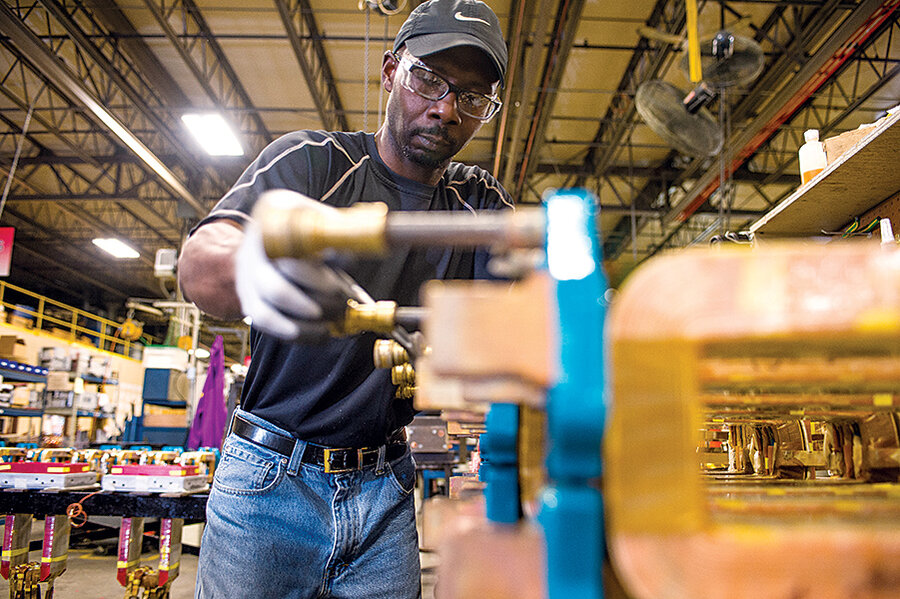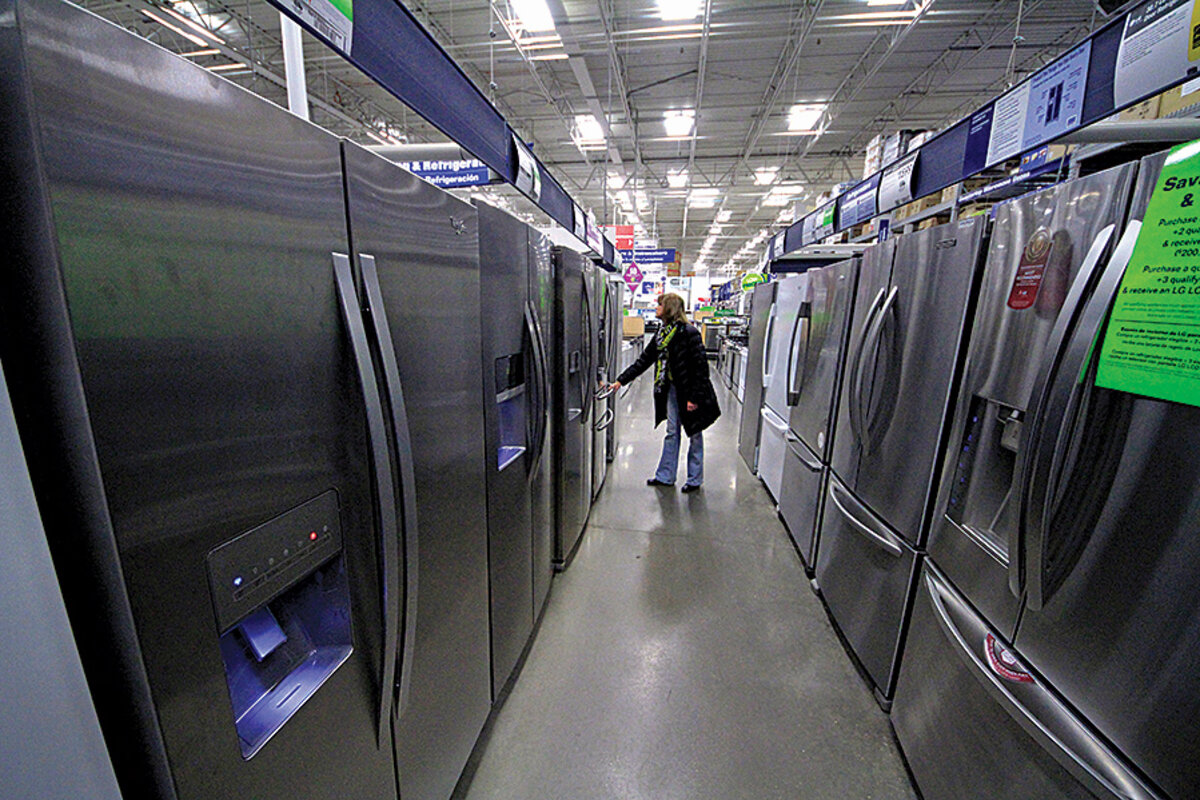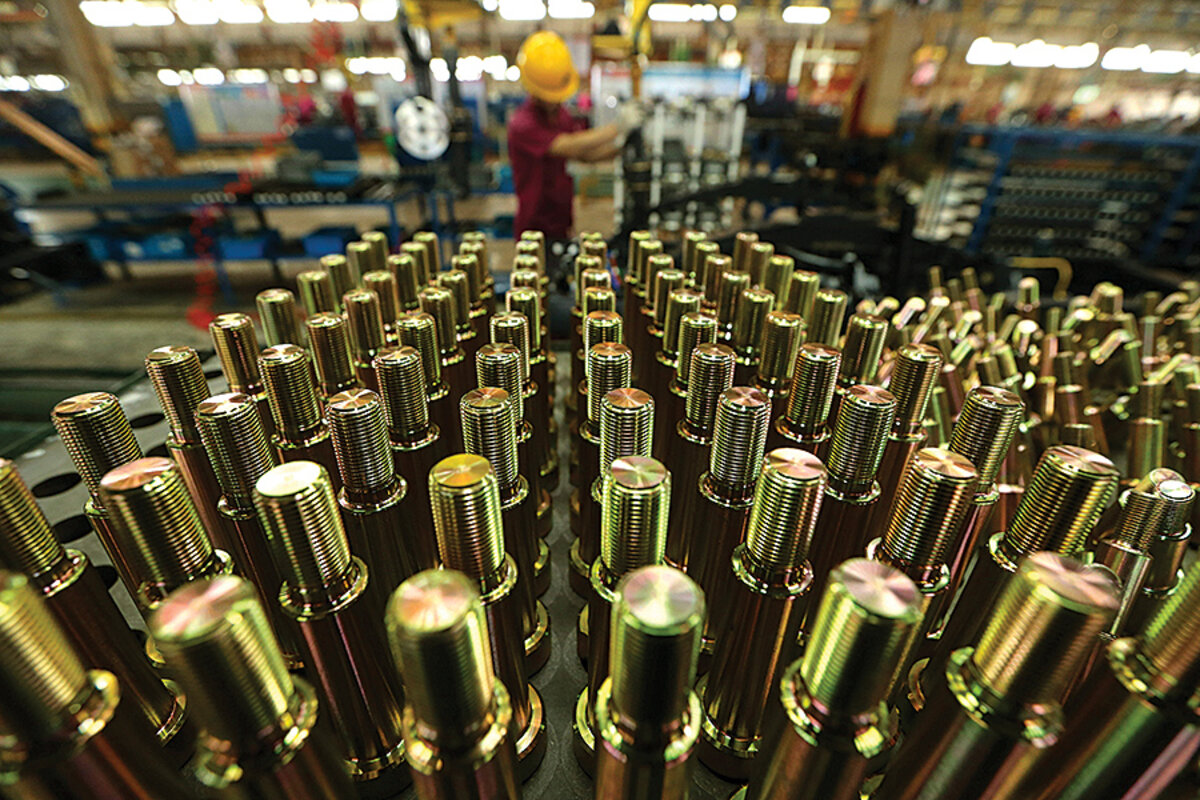The truth about US manufacturing
Loading...
| Shelby, N.C.; Madison, Maine; and Grand Rapids, Mich.
Tom Fitch remembers attending a community meeting one night in 1997 at the North Lake Country Club here in Shelby, N.C., a small city of red-brick storefronts and wide boulevards. He listened as members of the local business establishment praised the North American Free Trade Agreement (NAFTA), which three years earlier had opened up commerce with Mexico and Canada. The leaders envisioned the pact giving local businesses, including the textile plants that had operated in the area for decades, millions of new customers and boosting job growth.
Not Mr. Fitch. The owner of a boutique sign business, he already stood out amid the suit-and-tie crowd in his jeans and beaked cap. His concern was that the implementation of NAFTA would flood the United States with cheap imports and shutter local mills. He turned out to be prescient. Shelby lost 40 percent of its factory jobs between 1999 and 2014 and saw the poverty rate rise to double the national average. “Here, these guys were saying how their profits had increased, and I stood up and asked them why they couldn’t see what was in front of their faces: This was going to destroy our town,” recalls Fitch.
Yet today not all is dire. A small renaissance is under way in the area, some of which is tied to globalization. Schletter Inc., the US subsidiary of a German solar-panel manufacturer, has hired 305 people. Longtime furniture company Bernhardt has reopened a facility with 65 jobs. Clearwater Paper Corp. has added 65 positions, while automotive parts maker KSM Castings has taken on 189 new people.
“Up until a year and a half ago, people were still very much panicking about the future,” says Chris Carrigan, a sheet-press operator at a local printing plant. “But it seems like since then, the work has been steadier, and things are picking up.”
Shelby’s failures and fortunes represent a microcosm of the US in the era of more open global commerce. As free trade has become a dominant issue in the US presidential campaign – perhaps more than at any time since the 1930s – it is often portrayed in stark, one-dimensional terms: as a menace that has cost the US millions of jobs while enriching countries such as China and Mexico.
There is some truth in this dark narrative, as put forth most vociferously by GOP presidential candidate Donald Trump and, during the primaries, by insurgent Democrat Bernie Sanders. Free trade has resulted in a vast number of US manufacturing operations moving offshore. It has caused the loss of hundreds of thousands of jobs and hit certain communities, like Shelby, particularly hard. It has helped hold down the incomes of low-wage workers, and engendered a sense of angst among working-class Americans that has been overlooked by much of the political establishment.
Yet free trade has not been universally villainous. American consumers have saved millions of dollars by buying foreign electronics, cars, and couches for less than if they had been made domestically. The pacts have led to the rise of many higher-end manufacturing operations here. Free trade may have helped some American companies survive when they otherwise wouldn’t have: They were able to compete in the new global environment by moving manufacturing plants to low-wage countries and keeping better-paying administrative, marketing, and other operations here.
Perhaps most significant, many of the jobs that have been lost in US manufacturing in the past 10 years were not the result of malevolent free-trade deals at all. They were caused by the inexorable rise of automation, even though that fact provides little solace to workers shorn of their paychecks.
“The fundamental betrayal goes beyond trade – it’s a sense that we’re working hard and we’re getting screwed by the system ... a sense that, ‘This isn’t the America I grew up in, or the America I expected,’ ” says I.M. “Mac” Destler, a University of Maryland political scientist and author of “American Trade Politics.” “And that’s why trade is more prominent today than it’s been in any presidential campaign since, well, the Great Depression.”
All this is important because the next president will face major decisions about how open global commerce should be.
The US seems likely to retreat somewhat from the freewheeling free-trade ethos of the past two decades no matter who wins the White House. Even Democrat Hillary Clinton, who has supported free trade in the past, says she now won’t support the Trans-Pacific Partnership – a massive trade pact involving the US and 11 other countries.
The question is: How much should the US pull back from free trade – if at all? And how much has the country really been hurt by the freer cross-border flow of everything from mufflers to muffin tins?
• • •
For nearly a century, Shelby was a thriving notch in a Textile Belt that ran from the western Carolinas into northern Georgia. At its peak it had more than a dozen mills that produced yarn and fabric for apparelmakers and other outlets, employing thousands of workers, among them legendary bluegrass banjo picker Earl Scruggs, one of Shelby’s favorite sons. An eponymous music center now stands downtown to honor the late musician.
In 1970, more than 2.3 million Americans worked in garment and textile factories. By 1993, the year President Bill Clinton signed NAFTA, that number had fallen to about 1.6 million. Then came a surge in foreign fabric imports and the rise of China as a low-cost manufacturing colossus. Towels and bed linens sold at Wal-Mart were no longer made in American mills. In Shelby, some factory owners invested in new machinery to automate processes and cut labor costs. But few survived the onslaught of foreign competition. One by one, the mills closed, leaving middle-aged workers with no paychecks or pensions.
This decline mirrors a broader trend: Since 1970 total US employment in manufacturing has fallen by nearly a third. But the trend in output is going in the opposite direction. In 2015, the US produced goods valued at $2.2 trillion, up from $1.7 trillion in 2009 at the peak of the Great Recession.
Simply put, American factories and workshops are producing more by using less labor and more machinery, a process of capital investment and automation that has also transformed American farms.
The effect of automation on labor markets is deeper than the disruption caused by cheap imports. A 2013 Massachusetts Institute of Technology study by economist David Autor and two coauthors found that inexpensive Chinese goods accounted for about a quarter of the decline in US manufacturing jobs between 1990 and 2007, a period that includes the adoption of NAFTA and China’s entry into the World Trade Organization. But their data also suggest that many more jobs were lost because of robots, computers, and sensors.
Combined, the forces of automation and trade competition have decimated blue-collar jobs and the wages they pay. In 2003, the median hourly wage in a US automotive parts factory was $18.35; a decade later it was $15.83. The 2008-09 recession only added to the woes of the working class.
While the presidential campaign has highlighted the backlash against free trade among Rust Belt workers – who happen to live in valuable swing states – the same competitive forces are roiling industries elsewhere.
In Madison, Maine, a one-stoplight town on the banks of the Kennebec River, the closure of a paper mill in May has stirred debate over cheap imports abetted by foreign subsidies. The difference is that the villain is not China or Mexico, but Canada.
The closure of the cavernous, blue-roofed pulp and paper mill with the loss of more than 200 jobs ends more than a century of paper production in Madison (pop. 2,630.) It’s one of several paper mills in Maine that have closed in recent years, undone by a shrinking market, high energy costs, and competition from Canada.
“We’re losing jobs in America,” says Russ Drechsel, president and chief executive officer of Madison Paper Industries. “It’s an unfair trade. I don’t believe in subsidies.”
On a recent morning before the closure, he walked through the mill, which sits on 30 acres that hug the Kennebec. A giant roll of proto-paper the width of a bus spun on cylinders, then passed through roaring dryers to wring out the pulp’s water and bond the fibers together. The heat required to turn logs into pulp, and then steam and dry the paper, meant that the mill consumed roughly double the power that its two hydropower dams produced.
Inside a control room, Mr. Drechsel talked to workers about their severance and benefits and asked if they had all the information they needed. He noted that he had employees who had followed their parents into the mill. One young recruit who joined in 2015 was a third-generation millworker. Each job, local officials say, helps support as many as five people in Madison and other towns, from restaurant workers to barbers, real estate agents to mechanics.
At its height in the 1960s, the paper industry employed more than 18,000 workers in Maine. By 2011, that number had fallen below 6,000. Since then, four of 11 mills have closed; Madison is the fifth.
The company’s problems began in 2012, when the provincial government in Nova Scotia stepped in to rescue a bankrupt paper mill in Port Hawkesbury, providing loans and subsidized power to save hundreds of local jobs.
By 2015, Madison was reducing shifts and idling machinery after a severe winter that drove up energy prices. Together with another paper company, it filed a petition with the US Department of Commerce seeking import duties on the Port Hawkesbury mill for unfair subsidies. Last November, the Maine plants won their case: The US imposed countervailing duties of 20 percent on imports from the Nova Scotia plant (an appeal is pending).
But it came too late to save Madison Paper. Drechsel says that even with the import duties on Canadian paper, it would be hard to compete because the strong US dollar makes Canadian imports much cheaper.
The loss of Madison’s biggest taxpayer is a blow, but it represents only a fifth of the town’s tax base, much less than in the past. The town is hoping to find another tenant for the mill site, though it’s more likely that a buyer would want just the hydropower plants.
“Growing up here, we were always told that the day that mill closes up, we’re going to dry up and blow away,” says Tim Curtis, the town manager. “It won’t be easy. It’s a loss.”
Yet even in a struggling industry, opportunities exist. Ever since the closure of Madison Paper was announced earlier this year, its skilled workers have been getting offers from other paper mills. Those with the right résumé can get hired – provided they are willing either to commute or to relocate to another mill town.
For generations of Americans, this was a way to survive in bad economic times: Move to where the jobs are. From the gold rush to the Dust Bowl exodus, pioneers, dreamers, and immigrants have built America by migrating to the next opportunity.
Lately that spirit of mobility has diminished, undermining a key shock absorber of the US economy. No one is quite sure why. An aging nation might be less footloose. Certainly the rise of dual-
earner families means it’s harder for two people to uproot and leave. Soaring housing costs make some cities unaffordable. Underwater mortgages make other cities hard to leave. But one theory points to something deeper: Americans have adopted a bunker mentality as wages have stagnated.
“Something is shifting in how workers make transitions in the labor market,” says Abigail Wozniak, a labor economist at Notre Dame University in Indiana and coauthor of a 2014 study of internal migration. Her research suggests that fewer Americans find it’s helpful to move, because the chances of finding a significantly better salary are low and the chances of being laid off again are high. Without the possibility of better work, mobility has slowed. This trend began in the 1970s and cuts across industries, socioeconomic classes, and generations.
During the Great Recession, mobility did pick up. But the movement of job seekers didn’t correspond with the regions mired in the deepest downturns. For example, job-related moves rose in states such as Florida that had plentiful construction jobs. The highest out-migration rates during 2007-10 were in Idaho (2.1 percent), Nevada (1.6 percent), and Alaska (1.2 percent). The rate in Michigan, where factory employment took a huge hit, was only 0.3 percent.
“The ‘worst’ places in America are not the ones that are losing population,” says Mai Chi Dao, an economist at the International Monetary Fund who has studied labor mobility. “If [mobility] comes down, it means it will be a longer recovery and more pain after each recession.”
This raises the question of whether the US will need to act more like Europe, where mobility within national borders has long been less prevalent – and where countries have to spend more to retrain workers. “When you have a less mobile workforce the need to retrain becomes far more urgent,” says Jacob Funk Kirkegaard, a senior fellow at the Peterson Institute for International Economics in Washington.
In the US, federal aid for workers who lose their jobs because of foreign trade comes via Trade Adjustment Assistance, or TAA. It offers extended unemployment benefits, occupational retraining, and relocation money.
Through 2021, Congress has allocated $450 million a year in grants for TAA-qualified workers – less than what the US spends on unemployment benefits in a week and much less than what other advanced nations spend on trade adjustment. In 2011, the US spent 0.1 percent of its gross domestic product on active labor market policies, primarily TAA. This compares with 0.3 percent in Canada, 0.8 percent in Germany, and 2.3 percent in Denmark.
Studies show that people who take TAA training find jobs at higher rates than people who simply look for work while cashing unemployment checks. But older workers have less success in finding work and earning comparable salaries.
For Mohamed Moussa, a third-generation autoworker, the opportunity for retraining was transformational. While working at a Ford Motor Co. plant, he had managed to study part time and get a bachelor’s degree in radiation therapy in 2005. So when he lost his job in 2008 he was ready to start a new career. Five years later, he had a medical degree and was working as a resident in a hospital emergency room. Unlike many of his classmates, he was only $50,000 in debt. “It’s been a long winding road,” he says. “I try not to lose sight of that.”
Terry Hernden has benefited from starting over, too. When he was laid off in 2011 from his job at an injection-molding plant, he used TAA funds to enroll at a community college to study information technology security. After two years, he had an associate degree that he parlayed into a full-time job at Quicken Loans, a Detroit-based mortgage lender.
Today, Mr. Hernden works long hours – usually 12-hour shifts. But he earns more than he did in the auto industry and is upbeat about his prospects. “You definitely have to work hard,” he says. “It’s not like it used to be when you could walk into Ford and get a good job.”
Not everyone will have to retool their career in order to find work. As some of the emerging new industries in Shelby show, the story of US manufacturing is not all layoffs and closures. Since the Great Recession, a number of plants have reopened or expanded operations in the area.
The local economic development office says that Cleveland County, of which Shelby is a part, has created 1,863 new jobs and attracted $1.8 billion in capital investment in recent years. This is giving a boost to other businesses: Shelby now has a trendy tapas restaurant and a craft brewery.
Nationwide, what’s left of the US manufacturing sector is relatively healthy. In fact, in some regions, the problem isn’t whether plants have too many workers. It’s whether they have too few.
The National Association of Manufacturers projects that more than half of the 3.5 million factory job openings in the next decade will go unfilled. The reason is a general shift: Tens of thousands of boomers are now retiring each year, and Millennials are reluctant to take their jobs. They prefer to work in other industries that pay just as well – and that don’t come with the stigma of 40 years of downsizing.
“We’ve never had so much attention from manufacturers,” says Julie Parks, executive director of workforce training at Grand Rapids Community College in western Michigan. “They’re calling and saying: ‘Can we meet your students?’ They’re asking, ‘Why aren’t they looking at my job postings?’ ”
The Grand Rapids area offers a contrast to Detroit’s gritty struggles. Unemployment is low (around 3 percent, compared with a statewide average of 5 percent). Few workers are waiting for a job. And the need is high: 1 in 5 people works in manufacturing, churning out auto parts, machinery, plastics, office furniture, and medical devices. Other industries, including agribusiness and life sciences, want the same workers. The talk in the area is of growing trade and attracting foreign investment, not erecting barriers.
At RoMan Manufacturing Inc., a maker of electrical transformers and welding equipment, president and chief executive officer Robert Roth closely monitors the age of his nearly 200 workers. Five are retiring this year. Mr. Roth, whose father cofounded the company in 1980, has three community-college students enrolled in a work-placement program, with a starting wage of $13 an hour that rises to $17 after two years.
At a worktable inside the transformer plant, young Jason Stenquist is trying to assemble some copper coils. It’s his first week on the job. In high school, he considered pursuing a medical career but then switched to electrical engineering. “I love working with tools,” he says. “I love creating.”
To win over these young workers, manufacturers have to overcome the taint of the past. Millennials “remember their father and mother both were laid off,” says Birgit Klohs, president and chief executive of The Right Place, a business development agency for western Michigan. “They blame it on the manufacturing recession.”
The agency supports a public-private initiative that promotes the virtues of manufacturing to the next generation by hosting job fairs and sending a mobile demonstration vehicle to rural schools. One of the group’s messages is that factories are no longer dark, dirty, and dangerous. Workers today are more apt to run a sophisticated computer system than to grease ball bearings, and recruits can receive apprenticeships that include free tuition for college classes.
“[Workers] are harder to find and they have job offers,” says Jay Dunwell, president of Wolverine Coil Spring Company, a family-owned firm in Grand Rapids. “They may be coming [into the workforce], but they’ve been plucked by other industries that are also doing as well as manufacturing.”
The competition for workers is evident in Charlotte, N.C., 40 miles east of Shelby. The city is booming on the back of foreign trade. Nearly 1,000 foreign companies have taken advantage of tariff reductions to open facilities in the area, including a German specialty chemicals company, a South Korean plant that makes sheet-metal components, and a Chinese yarn-spinning firm. Charlotte’s population has grown by more than 50 percent since 2000. It is rated No. 5 among large cities in the country for job growth.
Yet many of the new workers aren’t getting rich: In 1999, the median household in Charlotte earned $5,000 more than the US average; by 2014, it was only on par.
As with so much of the national debate on trade and globalization, how people view the issue often depends on where they started and where they stand now.
“In these trade agreements, the winners in America hugely outweigh the losers,” says Matthew Gold, a former deputy assistant US trade representative who now teaches law at Fordham University in New York. “The political problem is that the losers know exactly who they are, exactly how much they lost.”
The above story was a digest of the five-part series that appeared in June.
Free Trade in America
Part 1: The harsh downside of free trade – and the glimmer of hope
Part 2: The surprising truth about American manufacturing
Part 3: What 'good' free trade looks like
Part 4: Why, this time, free trade has hit American workers so hard
Part 5: What can be done about free trade's 'victims'










